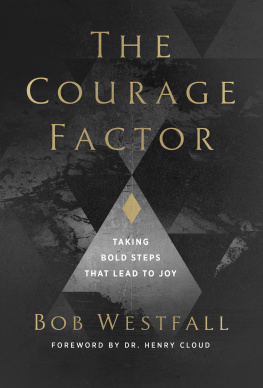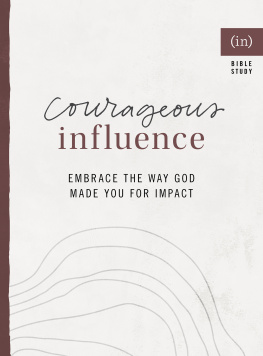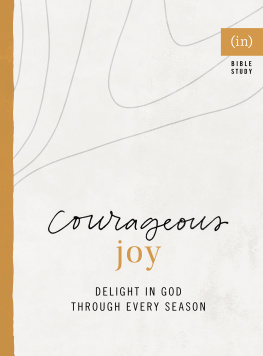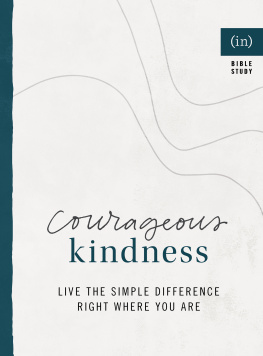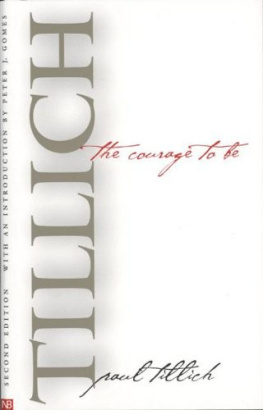Table of Contents
More Praise for The Courage Quotient
I love this book! Robert Biswas-Diener brings courage to life, showing us all how we can overcome our fears and achieve what is important to us. Grounded in the latest research and illustrated with Robert's interviews with the Courage 50, as well as his own stories of courage, he shows us just what courage is, how we can develop it, and how life can be so much better when we do. In the modern world, we need people with the courage to stand up and take action to improve the lives of all. Robert Biswas-Diener shows us how to do this in his latest groundbreaking book.
Alex Linley , PhD, founding director, Capp (www.cappeu.com); author, The Strengths Book
In his book, Robert Biswas-Diener teaches us valuable lessons about courage. As a leader, you need courage: courage to make yourself vulnerable to others. Leadership takes making bold and sometimes unpopular decisions. Courage is crucial in a wide range of work situations, and anyone in a company can demonstrate courage leadership.
Heinz Landau , former chairman and managing director, Merck Ltd., Thailand
Dr. Biswas-Diener has a deep understanding of and empathy for the human condition and the willingness to engage forthrightly with challenging issues that most people would rather not have to think about. This book is the most fascinating and accessible exploration of courage since The Right Stuff , with the critical advantage of being based on rigorous and thorough scholarship and research. Engaging, witty, and incisive, the book offers a wealth of insight and practical advice on how to be braver, how to accept being different from the herd while doing soand why this matters to you. Every person in a leadership position should read this book, because as Winston Churchill once pointed out, Courage is the quality that guarantees all others.
Sunny Stout-Rostron , executive director, Sunny Stout-Rostron Associates; author, Business Coaching International: Transforming Individuals and Organizations
Copyright 2012 by John Wiley & Sons, Inc. All rights reserved.
Published by Jossey-Bass
A Wiley Imprint
One Montgomery Street, Suite 1200, San Francisco, CA 94104-4594www.josseybass.com
No part of this publication may be reproduced, stored in a retrieval system, or transmitted in any form or by any means, electronic, mechanical, photocopying, recording, scanning, or otherwise, except as permitted under Section 107 or 108 of the 1976 United States Copyright Act, without either the prior written permission of the publisher, or authorization through payment of the appropriate per-copy fee to the Copyright Clearance Center, Inc., 222 Rosewood Drive, Danvers, MA 01923, 978-750-8400, fax 978-646-8600, or on the Web at www.copyright.com. Requests to the publisher for permission should be addressed to the Permissions Department, John Wiley & Sons, Inc., 111 River Street, Hoboken, NJ 07030, 201-748-6011, fax 201-748-6008, or online at www.wiley.com/go/permissions.
Limit of Liability/Disclaimer of Warranty: While the publisher and author have used their best efforts in preparing this book, they make no representations or warranties with respect to the accuracy or completeness of the contents of this book and specifically disclaim any implied warranties of merchantability or fitness for a particular purpose. No warranty may be created or extended by sales representatives or written sales materials. The advice and strategies contained herein may not be suitable for your situation. You should consult with a professional where appropriate. Neither the publisher nor author shall be liable for any loss of profit or any other commercial damages, including but not limited to special, incidental, consequential, or other damages. Readers should be aware that Internet Web sites offered as citations and/or sources for further information may have changed or disappeared between the time this was written and when it is read.
Jossey-Bass books and products are available through most bookstores. To contact Jossey-Bass directly call our Customer Care Department within the U.S. at 800-956-7739, outside the U.S. at 317-572-3986, or fax 317-572-4002.
Wiley publishes in a variety of print and electronic formats and by print-on-demand. Some material included with standard print versions of this book may not be included in e-books or in print-on-demand. If this book refers to media such as a CD or DVD that is not included in the version you purchased, you may download this material at http://booksupport.wiley.com. For more information about Wiley products, visit www.wiley.com.
Library of Congress Cataloging-in-Publication Data
Biswas-Diener, Robert.
The courage quotient : how science can make you braver / Robert Biswas-Diener. 1st ed.
p. cm.
Includes bibliographical references and index.
ISBN 978-0-470-91742-8 (cloth); ISBN 978-1-118-20683-6 (ebk.); ISBN 978-1-118-20684-3 (ebk.); ISBN 978-1-118-20685-0 (ebk.)
1. Courage. 2. Fear. I. Title.
BF575.C8.B57 2012
179.6dc23
for the inspiring passengers of united flight 93
Introduction: How I Found Courage
I learned much about courageand much about myselfon one of my first jobs out of graduate school. I got my start in academia as a researcher in happiness. That's righthappiness. I have spent about a decade of my professional career studying what makes people happy. I have lived and worked with a number of fascinating groups from around the world, including Amish farmers in the American Midwest and seal hunters in the far north of Greenland. With each group I try to get a sense of what is good about local life, where people find their personal fulfillment, and how happy people are in general. In this particular instance I was looking forward to studying the happiness of the Maasai tribal people of southwest Kenya. In many ways the Maasai are the poster children for tribal Africa. Anyone who has been on safari in that part of the world has likely come across the Maasai in tourist shows (they perform huge vertical leaps), in crafts markets (what are you going to do with that club once you have brought it back to your home?), or in postcards. The Maasai are a visually striking people. They tend to be on the skinny side, and elongate their earlobes and wear bright-red wool cloaks. Local lore holds that lions recognize the red color and become afraid because they know the Maasai are so dangerous. And it's not far from the truthon a walk one day deep in the African bush I pointed to a small tree some distance away and a young warrior heaved his metal-tipped spear through the air and split the tree right through the base of the trunk.
In my head the whole notion of conducting research with the Maasai was all very Indiana Jones: I hired local translators and drove a jeep across the lush Great Rift Valley until we arrived at a remote manyatta , a Maasai village, nestled in a grassy savannah below a stubby, brush-sided hillside. Twin dirt tracks led to a flat place where sticker bushes and braided twigs had been fashioned into livestock pens. Around these pens were more than a dozen homes, each about six feet tall and constructed from dried mud and cow dung. Here and there bits of newspaper and plastic were dragged lazily by the wind. A few curious children ran forward at the sound of our engine. I was absolutely elated to be on the cusp of first contact with a group of people who live largely outside of the world economy. The Maasai are pastoralists, which means they herd cows and goats and count their wealth not in Kenyan shillings but in livestock. Young and old, men and women, they gathered around the research team.
Next page

